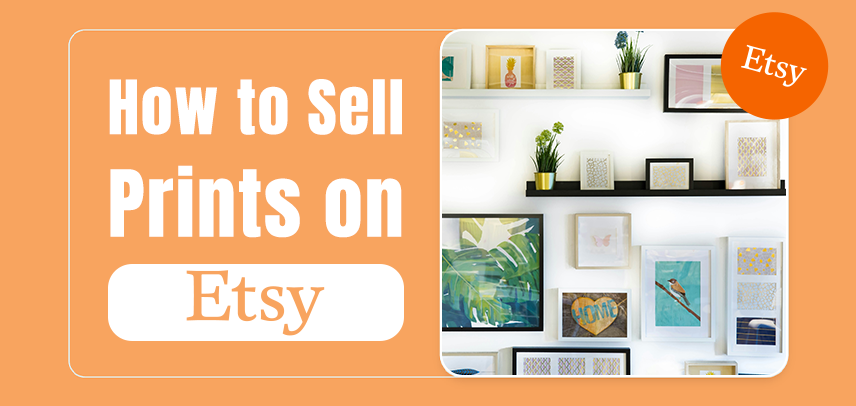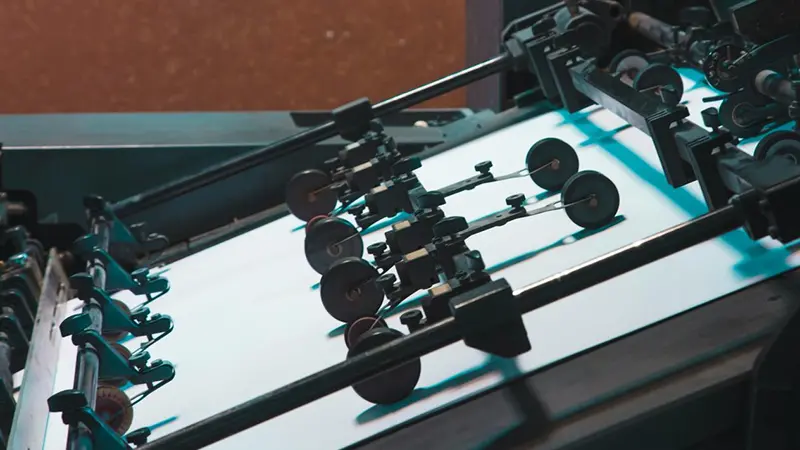
How to Sell Prints on Etsy Successfully (2025)
Are you an entrepreneur or an artist looking to turn your imagination into money? One of the best ways of ensuring you can market your work and earn a living from it is by posting items on the Etsy platform. The only question remaining is how to sell art prints on Etsy.
In this ultimate guide to selling prints on Etsy in 2025, we’ll take you through all that is required to have a successful Etsy shop. This blog has all the information useful for those who would like to make a living out of their skills.
This information will be handy whether you are a newcomer to the world of selling or a professional seller on Etsy!
Is it Profitable to Sell Art Prints on Etsy?
Absolutely! Here’s why: In 2019, Etsy made revenue of $2.74 billion, an increase of seven percent from the previous year. This growth also underlines the platform’s strong and continuously growing marketplace, which is always a positive aspect for potential sellers.
Based on the current data, Etsy has over 91.6 million active buyers, which gives the sellers access to a ready-made audience interested in purchasing individual and extraordinary products.
Furthermore, Etsy hosts 8.3 million sellers, which depicts it as a lively and active platform where quality goods can freely sell regardless of the presence of cutthroat competitors.

Why Choose Etsy to Sell Prints
Large Global Community
They have a very large community around the globe, which is good news for your art prints as your buyer base can be global.
As a site that caters to niche and non-mainstream goods, the ability to reach people looking for art prints is quite big due to the platform’s provided search.
Fewer Overhead Expenses
Etsy’s overhead expenses are lower. Compared to other forms of art selling, such as having a gallery or participating in an art show, selling on Etsy means having to spend less. This makes it possible to offer attractive prices to customers when they buy the prints.
At the same time, the company can earn good profits, making it one of the cheapest means of marketing the products.
Ease of Use and Scalability
It is very simple to open up an Etsy shop and easy to navigate. Furthermore, all the platform’s tools embody scalability, meaning your business can opt for wider product offerings and higher production rates as it develops.
These advantages facilitate stock control. According to demand and sales, it will also affect the frequency and methods of marketing commodities.
Advertising and Selling Aids Available at Etsy
Etsy offers different tools that may help in selling and marketing your prints, including Etsy Ads. Although social media integrations may not always directly sell products, they are a good way to advertise your shop.
Which Types of Prints You Want to Sell on Etsy
What type of prints you will consider when deciding how to sell prints on Etsy? Here are two popular options: digital prints and physical prints.

Digital Prints
Digital prints are virtual prints that customers can buy online and then obtain a hard copy via a printer. Peculiarities of this type of print are beneficial for both the sellers and the buyers in several ways.
Pros:
- No Inventory: Since digital prints are files, there’s no need to maintain physical stock, reducing storage concerns.
- No Shipping and Processing: Digital downloads eliminate the need for packaging and shipping, streamlining your sales process and reducing associated costs.
- Infinite Stock: Digital art can be sold an unlimited number of times, ensuring you never run out of inventory.
- Lower Costs to Produce: Creating digital prints typically involves lower production costs, as you only need design software and skills rather than physical materials.
Physical Prints
Physical prints involve printing your artwork onto diverse products such as canvas, wall art, and even items like pillows. These tangible items can be shipped directly to customers, offering a different set of benefits.
Pros:
- High Profit Margins: Physical prints can be sold at higher prices due to the perceived value of a tangible product, leading to greater profit margins.
- Decreased Risk of Copyright Issues: Selling physical prints reduces the risk of copyright of your work, as buyers receive a finished product rather than a file they could potentially misuse.
It is important to determine whether to go for the physical print or digital print depending on the objectives of the business, available capital, and needs of the clients. The two are different in their features and can both be lucrative when done in the right manner on Etsy.
How to Sell Art Prints on Etsy
Set Up an Etsy store
Setting up an Etsy store is straightforward and can be done in a few simple steps:
- Create an Account: Go to the homepage, then click on “Sign in” or “Register” to get started.
- Open Your Shop: Click on “Sell on Etsy” and follow the prompts to open your shop. Choose your shop’s name carefully; it should be unique, memorable, and reflective of your brand.
- Add Listings: Click on “Add a listing” to start showcasing your art prints. Upload high-quality photos, write compelling titles and descriptions, and set your pricing.
- Set Up Payment and Billing: Choose how you want to get paid (Etsy Payments is recommended for most sellers) and provide your billing information to cover any Etsy fees.
- Customize Your Shop: Add a shop banner, logo, and bio to create a professional and cohesive look. Setting up shop policies regarding shipping, returns, and exchanges is also crucial.

Define Your Target Audience
Start by narrowing down your niche to specific, high-potential areas using tools like Erank, Google Trends, BuzzSumo, or Semrush. These platforms’ search results can help you identify trending topics and popular keywords that align with your art style.
Researching competitors in your chosen niche is also essential. Analyze what they are doing well and identify market gaps.
Finding your unique selling points (USP) will set you apart from the competition. It is about identifying what is special about you and what you will do that none of your competitors can do.
Explain and overview your fine art and motives, especially the concept of your prints. It is important to say what you think about your artwork and showcase what makes it special.
Prepare Your products
Decide Products to Sell
To attract a wide audience, consider combining your art prints with functional items that enhance their usability. Offering diverse product formats allows you to cater to different tastes and needs. Some top-selling print products on Etsy include:
- Wall Art: This classic format is ideal for showcasing your artwork in various styles, from minimalist prints to elaborate designs.
- Canvas Prints: Known for their premium feel, canvas prints provide a textured, durable option for displaying art.
- Posters: Posters are versatile and affordable, making them a popular choice for art enthusiasts looking to decorate their spaces without a significant investment.
- Stickers: Fun and budget-friendly, stickers allow customers to personalize everyday items with your artwork.
- Mugs: Custom mugs featuring your art are great for daily use and make excellent gifts.
- Pillows: Art-printed pillows add a decorative touch to home decor.
- Postcards: Art postcards are ideal for those who enjoy sending personal notes or collecting unique cards.
- Apparel: Featuring your designs on items like T-shirts, tote bags, and scarves can attract customers looking to wear or carry your art.
For a comprehensive range of product options, Inkedjoy offers an extensive catalog that can help you bring your designs to life. Whether you’re interested in canvas prints, mugs, or apparel, Inkedjoy provides a variety of choices to fit your artistic vision.

Upload Your Art Prints
When uploading your art prints to Etsy, presentation is key. Here’s how to upload the most of your products:
High-quality Photos
- Shoot It Yourself: Use a high-resolution camera and ensure good lighting to capture your prints clearly. Choose a clean, neutral background that complements but doesn’t distract from your artwork. Remember to add a watermark to protect your images from unauthorized use.
- Use Mockup Tools: To showcase your art in different contexts, use mockup tools to place your artwork in frames or on various products. This helps customers visualize how the prints will look in their homes. Inkedjoy’s mockup generator can be a valuable tool for creating realistic and high-resolution mockups of your prints.
Detailed Description
Write a detailed description for each listing with three main goals in mind:
- Inform the Buyer: Provide all necessary details about the print, including size options, materials used, and customization options.
- Search Engine Visibility: Use keywords in your description to improve SEO and help potential buyers find your products.
- Boost Conversion Rates: Write compelling copy that highlights the unique aspects of your prints and encourages customers to make a purchase.
Title and Tags
Craft descriptive titles that include relevant keywords to make your listings easy to find. Use tags to include synonyms, regional phrases, and long-tail keywords.
Avoid using your shop name as a tag and focus on keywords that potential buyers might use to search for your products.
Decide How to Produce and Ship Your Products
To streamline production and shipping, consider working with print-on-demand suppliers. These services handle the printing, packaging, customer service, and shipping so you can focus on creating art and managing your shop.
Pay attention to packaging as well, adding your brand logo to enhance your professional image.
Inkedjoy offers comprehensive print-on-demand services and packaging solutions that can help you efficiently manage production and shipping. Their wide range of product options and customizable packaging ensures that your prints are delivered in style and with care.

Price Your Art Prints
Pricing your art prints appropriately is essential for maintaining profitability while staying competitive. Consider all costs involved, including materials, production, size, time, and fees from both the print-on-demand supplier and Etsy.
Compare your prices with those of similar competitors to ensure your pricing is neither too low nor too high. Regularly check competitors’ prices to adjust your own as needed, keeping your products attractive to buyers.
Customize Your Etsy Store
Customizing your Etsy store effectively is crucial. Here’s how to make your shop stand out:
Build a Brand for Your Shop
Design a Shop Icon
Your shop icon is a small but important part of your Etsy presence. It represents your shop across the site, so choose simple graphics and minimal text that convey something meaningful about your brand. This icon should be easily recognizable and reflective of your artistic style.
Create a Banner
Your shop banner is a larger visual element that sets the tone for your store. Design it to the correct dimensions for optimal display:
- Big Banners: 3360 x 840 pixels
- Mini Banners: 1200 x 160 pixels
For an impactful banner, highlight your best photography and use text sparingly. The design should be clean and creative, aligning with your brand’s aesthetic.
Maximize Your Listing Photos
Ensure your listing photos echo the established design palette of your brand. This creates a good cohesive look and feel, catering to your target market and making your shop visually appealing.

Share Your Store’s Story
Fill Out Your About Section
Use the “About” section to share the inspiration behind your products and the reason you started you print on demand business.
This helps them understand the passion driving your creations.
Show Real People
Include photos of yourself and others involved in your creative process. This helps your shop feel more human and trustworthy.
Use the photo carousel to show images of your workspace, the process of making products, and behind-the-scenes moments.
Add a Video
Etsy promotes listings with videos, so consider adding a video that gives shoppers an intimate look at your products and your creative process.
This addition can significantly enhance engagement and provide a more personal shopping experience.
Market Your Products & Store
The last step in how to sell art work on Etsy is marketing! Effectively marketing your Etsy store and products is essential for driving traffic and increasing sales. Here’s how to leverage various strategies to boost your shop’s visibility and attract potential customer base:
Social Media Marketing
Social Media Handles
Make a presence on platforms like Instagram, Pinterest, and Facebook. These channels are powerful tools for reaching new customers and showcasing your art.
Use them to share visually compelling content that highlights your products and brand personality.
Engage with Your Audience
Routinely post updates about new products, promotions, and behind-the-scenes looks at your creative process.
Captivate potential customers with engaging content that encourages them to follow your shop and stay updated.
Announce New Products and Promotions
Use social media to keep your audience informed about new releases and upcoming sales.
Create visually appealing posts that drive traffic to your Etsy shop and boost interest in your offerings.

Email Marketing
Build an Email List
Collect email addresses from customers and interested shoppers to keep them informed about your brand.
Email marketing allows you to reach an audience that has already shown interest in your products.
Develop Monthly Newsletters
Consider creating monthly email newsletters that highlight company updates, new product launches, and relevant industry news.
This keeps your audience engaged and encourages repeat visits to your Etsy shop.
Etsy Ads
Etsy offers a straightforward and automated advertising platform that allows Etsy sellers to promote your listings directly within the marketplace.
Setting up Etsy ads is simpler compared to other ad services, and it can help increase visibility and drive traffic to your store.
Influencer Marketing
Align your brand with social media influencers and appeal to demographics similar to your target audience.
Collaborating with influencers can introduce your products to a broader audience and boost your shop’s credibility.
Sell Art Prints on Etsy With Inkedjoy
Wondering how to sell canvas prints on Etsy? Selling art on Etsy becomes effortless with Inkedjoy. Their extensive range of print-on-demand products, from canvas prints and mugs to apparel and phone cases, allows you to showcase your artwork in various formats.
Inkedjoy’s high-quality production and customization options ensure your art looks its best, while their seamless integration with Etsy simplifies order fulfillment and shipping.
By leveraging Inkedjoy’s services, you can focus on creating and marketing your small business, knowing that your print production and delivery are in expert hands.
Start selling with Inkedjoy today and elevate your Etsy shop’s success.

Bottom Line
Selling art prints on Etsy offers significant opportunities for artists and creators. By carefully choosing your product types, optimizing your listings, and leveraging platforms like Inkedjoy, you can effectively reach a broad audience and increase sales.
FAQs
What type of prints sell best on Etsy?
Wall art, canvas prints, and posters are among the best-selling types of prints on Etsy. Functional items like mugs and apparel also perform well, offering versatile options for customers.
What size prints sell best?
Medium to large sizes, such as 16×20 inches or 24×36 inches, tend to sell best. These sizes are popular for creating impactful visual statements in home decor.
How much does it cost to sell digital prints on Etsy?
Selling digital prints on Etsy involves listing fees of $0.20 per item with a fee of 6.5% for transactions on each sale. There are no additional costs for digital items beyond these fees.



